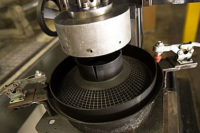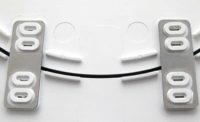Assembly Methods for Bioplastics
Plastics made from plant-based materials are increasingly being used in a variety of applications.
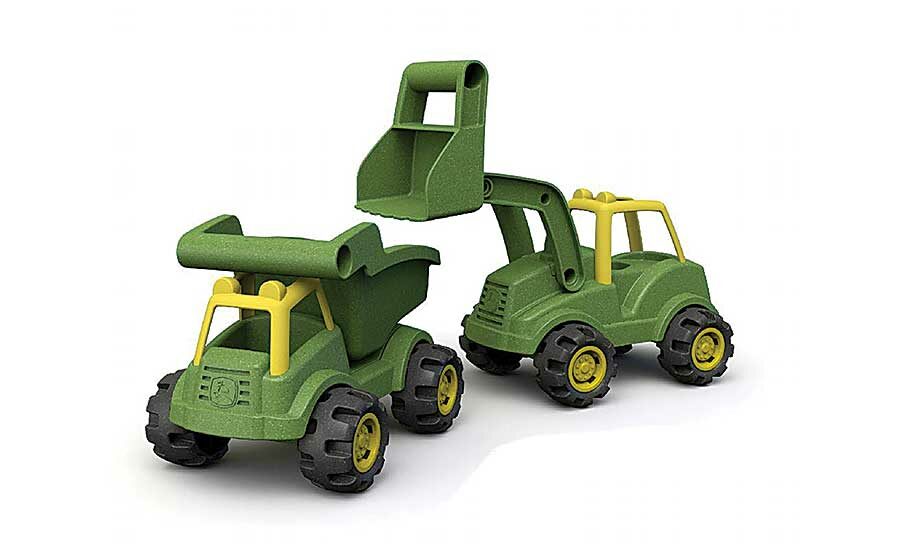
These toy tractors are fashioned from Terratek biocomposite, which combines polyethylene derived from sugarcane with corncob fibers sourced from Midwest farms. Photo courtesy Green Dot Bioplastics
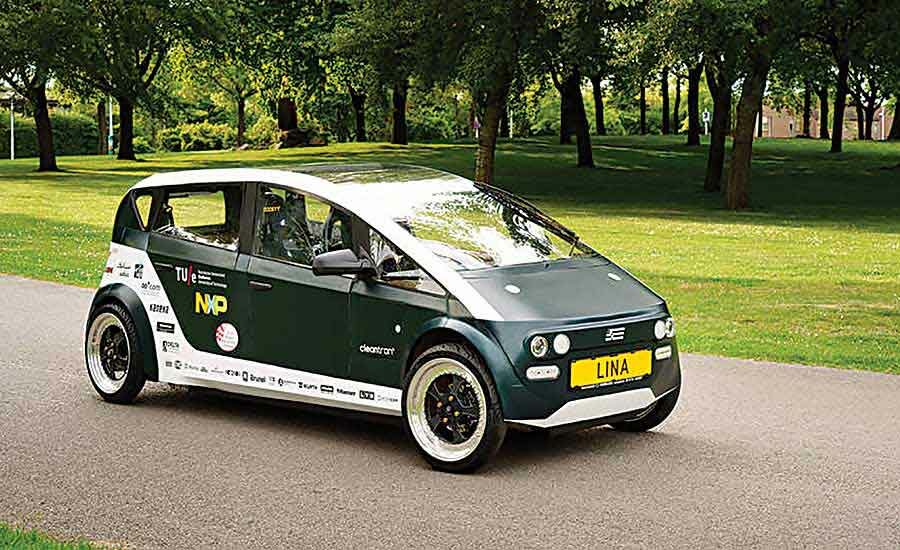
The chassis and body of this four-seat electric car were built from a honeycomb core made from bioplastic, sandwiched between sheets of a flaxbased composite material. The structure has a similar strength-to-weight ratio to that of fiberglass. Photo courtesy Eindhoven University of Technology
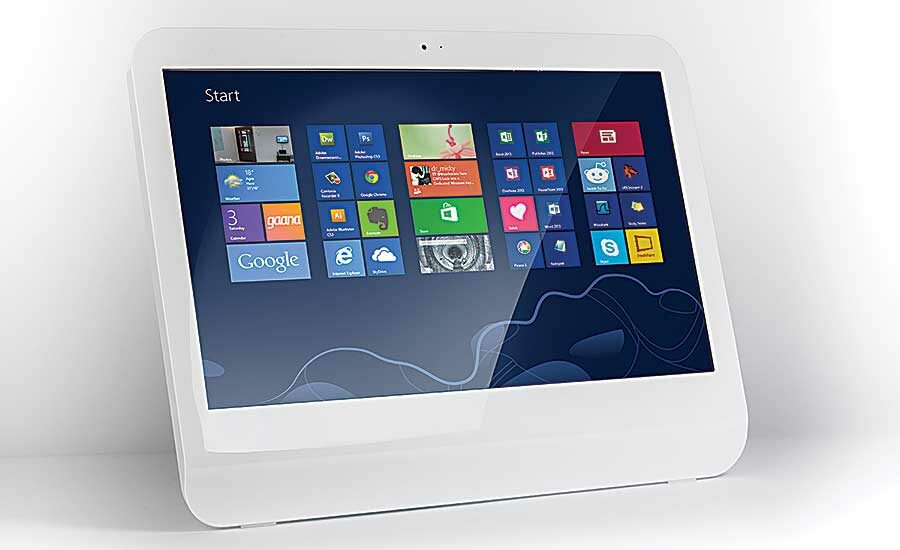
The shell of this tablet computer was molded from a bioplastic that has been formulated to resist impacts, scratches and heat. Photo courtesy Supla Material Technology Co. Ltd.
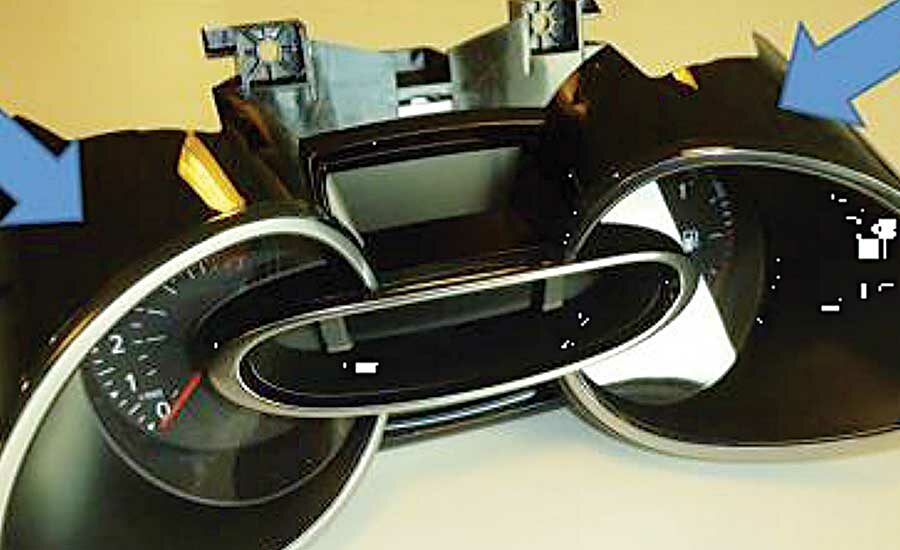
The shell of this automotive dashboard cluster is molded from Durabio, a bio-based polycarbonate derived mainly from plant-based isosorbide. Compared with conventional polycarbonate, Durabio features excellent optical properties and scratch resistance. Photo courtesy Mitsubishi Chemical Corp.
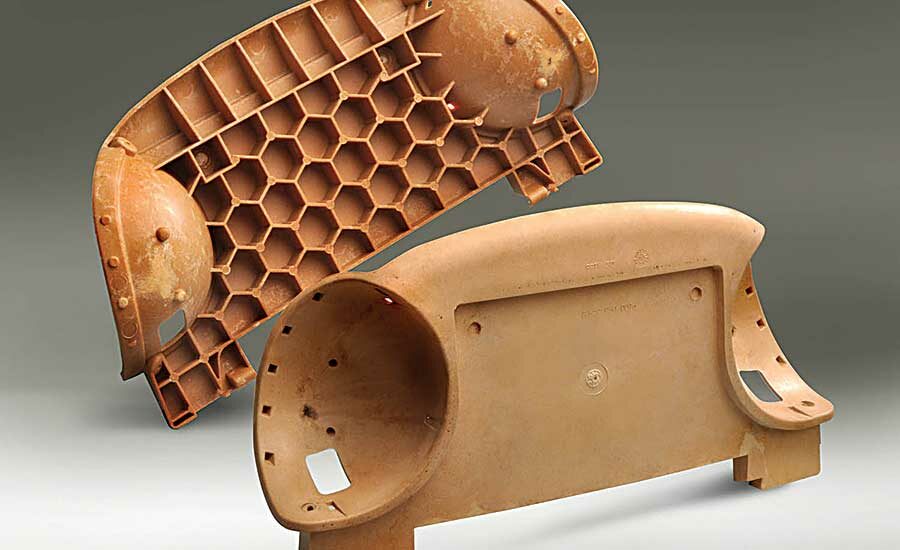
These automotive headrest components are molded from a biocomposite material called Jeluplast. The material consists of polypropylene reinforced with wood fibers. Photo courtesy JELU Werk





In January 2017, students from Eindhoven University of Technology in the Netherlands unveiled the world’s first car made almost entirely from bio-based materials.
Dubbed “Lina,” the four-seat electric car weighs just 661 pounds. The chassis and body were built from a honeycomb core made from polylactic acid (PLA)—a bioplastic derived from sugar beets—sandwiched between sheets of a flax-based composite material. The structure has a similar strength-to-weight ratio to that of fiberglass.
“Only the wheels and suspension systems are not yet of bio-based materials,” says Yanic van Riel, one of the students who worked on the project.
“Car manufacturers opt for lightweight materials, such as aluminum or carbon fiber, to create lighter, more efficient cars,” he adds. “However, processing of these materials requires five to six times more energy than steel, the material which they replace.”
Lina is powered by two DC motors and three lithium-ion battery packs. It has a top speed of 50 mph and maximum range of 62 miles on a full charge.
In response to the car-sharing trend, near-field communication (NFC) technology has been incorporated into Lina. Drivers gain access to the car using a smartphone or a card with an NFC chip. The car will recognize users by their unique identification codes, and activate their personal user settings, such as playlists, frequent destinations or telephone contacts.
While Lina is a long way from mass production, it nevertheless demonstrates just how far bioplastics have come in the past decade. New formulations are expanding applications for bioplastics beyond packaging and disposable beverage cups and into products such as automotive components, consumer products, electronics and even medical devices.
Indeed, market research firms are giddy over the prospects for these eco-friendly materials. Markets and Markets expects global sales of bioplastics and biopolymers to grow at a cumulative annual rate of 12 percent over the next few years, from a total of $2.66 billion in 2015 and to more than $5 billion in 2021. The Freedonia Group predicts the market for bioplastics will rise at a cumulative annual rate of approximately 20 percent from 2016 to 2024. And, Technavio forecasts that sales will increase at a cumulative annual rate of more than 29 percent through 2020.
While bioplastics may reduce consumption of natural gas and petroleum, they typically cost more than the petro-based products they replace. Rather, it’s consumer demand that is the driving force behind such rosy forecasts. For example, a 2015 survey showed that 84 percent of global consumers say they seek out responsible products whenever possible, and nine out of 10 consumers expect companies to address environmental issues.
Defining Terms
A variety of so-called “eco-friendly” or “green” plastics have been introduced during the past decade, and the terminology surrounding them can be confusing. There are bioplastics, biodegradable plastics and biocomposites, but they are not necessarily the same. The “green” label has been applied to all of these materials, as well as recyclable plastics and even high-strength engineering plastics, because they replace metal parts.
Bioplastics are made mostly or entirely from renewable plant materials. For example, PLA is a biodegradable polymer derived from lactic acid. It is made from 100-percent renewable resources, such as corn, sugar beets, wheat or other starch-rich crops. Bioplastics may or may not be mixed with petro-based polymers or fillers, such as glass fibers. Bioplastics may or may not be recyclable or biodegradable.
Biodegradable plastics can be broken down into their constituent compounds by naturally occurring microorganisms. Biodegradable plastics can be made from either plant-based or petro-based sources.
“When people think of bioplastics, they tend to gravitate to biodegradable materials like PLA or PHA [polyhydroxyalkanoate] or PBS [polybutylene succinate],” says David Grewell, Ph.D., professor of agricultural and biosystems engineering at Iowa State University and director of Center for Bioplastics and Biocomposites. “But there are a lot more bioplastics out there that are not biodegradable—things like the polyethylene produced by Braskem or the partially bio-based PET [polyethylene terephthalate] that the Coca Cola Co. uses for its bottles. These materials are one-to-one drop-in replacements for petroleum-based plastics. They don’t behave any differently than traditional polyethylene or PET. Those materials represent a much bigger market in terms of what’s going on with bioplastics.”
Then there are biocomposites: petro-based plastics or bioplastics reinforced with fibers derived from renewable plant resources—such as flax, hemp, kenaf or sisal—rather than glass or carbon fibers. For example, Ford Motor Co. is working with Jose Cuervo to develop ways to use agave fibers (a byproduct of tequila production) to create biocomposites for vehicles. Ford is testing the fiber-reinforced plastic for use in vehicle interior and exterior components, such as wiring harnesses, HVAC units and storage bins.
“Natural fibers have unique thermomechanical properties,” explains Grewell. “Glass fibers may be much stronger than some of these natural fibers. However, because natural fibers have a certain amount of flexibility, they tend to retain their length better as they’re going through an extruder or a mold. And, they’re much lighter than glass fibers, so there’s weight-saving potential as well.”
New Materials
Bioplastics have come a long way since the days when the primary application for these materials was disposable forks and spoons. New formulations have recently been introduced that can meet some demanding applications.
For example, Taiwanese plastic supplier Supla Material Technology Co. Ltd. has developed a PLA that has been optimized for use in consumer electronics, such as mobile phones, laptops and game consoles. Contract manufacturer Kuender Co. Ltd. is using the material to produce the plastic housing for a tablet computer. White in color with a high-gloss finish, the plastic provides high dimensional stability, which allows for tight tolerances during molding. It was also formulated to resist impacts, scratches and heat. The latter characteristic was a key development: In the past, a lack of heat resistance has limited the suitability of bioplastics for consumer electronics.
DuPont has introduced a series of bioplastics for automotive and other applications.
Hytrel RS thermoplastic elastomer bridges the gap between rubber and rigid plastics. Made using Cerenol, a renewably sourced polyol derived from corn, Hytrel RS provides all the performance characteristics of DuPont’s standard Hytrel material, but contains 20 to 60 percent renewably sourced material. Hytrel RS is easily processed with conventional thermoplastic methods, including injection molding, blow molding, calendering, rotational molding, extrusion, and melt casting. Applications include hoses and tubing for automotive and industrial uses, boots for constant velocity joints, air bag doors and energy dampers.
Zytel RS renewably sourced nylon resins are based on the Zytel PA1010 and PA610 grades, which are designed for high strength, heat resistance, chemical resistance, and overall durability. The renewable biopolymer content in Zytel RS grades comes from sebacic acid that has been extracted from castor oil, a non-food, plant-based source. A broad range of grades is available, with renewable content ranging from 20 to 100 percent. Hutchinson SA, a manufacturer of vibration control, fluid management and sealing products, is using Zytel RS to make fuel lines for diesel-powered cars and trucks.
Sorona EP poly trimethylene terephthalate, a thermoplastic polymer, is comprised of 20 to 37 percent corn by weight. Its strength and molding characteristics make it a natural replacement for PBT (polybutylene terephthalate) in industries from automotive to electronics to oil and gas. Sorona EP delivers good dimensional stability and finishing qualities, making it suitable for applications such as automotive parts, furniture, mobile phone housings and consumer products. DTR Medical, a manufacturer of single-use surgical instruments, has specified Sorona EP for six components of a cervical rotating biopsy punch.
Assembly Methods
Bioplastics can be processed with most conventional techniques, including extrusion, injection molding, blow molding and compression molding. They can be blown into films and spun into fibers for textiles and nonwovens. They can even be used with 3D printers.
Many of same assembly technologies that are used to join petro-based plastics, such as ultrasonic welding and vibration welding, can also join bioplastics, though finding the right settings will require some experimentation.
“PLA welds just fine with ultrasonics,” says Grewell. “Some of the amplitudes we were using were relatively low compared with some traditional plastics. PLA did not require a lot of energy. It didn’t require a lot of amplitude. It went together relatively easily.”
In tests done at Grewell’s Iowa State laboratory, ultrasonic welding of PLA films produced samples of relatively high strength. However, while ultrasonic welding of PLA can be done with fast cycle times, Grewell and his research team found the process to be less parameter-sensitive.
Kenneth Holt, senior applications engineer at Dukane Corp., says PLA does not require much energy to weld. With a 20-kilohertz welder, an amplitude of around 32 microns is typically enough to get the job done. That’s comparable to ABS or styrene acrylonitrile.
“However, slightly less pressure is needed because PLA flows more easily than other plastics,” he says.
Holt also warns that, because PLA and other bioplastics tend to be hydrophilic—they absorb moisture—welding processes could be adversely affected in high-humidity environments.
As with petro-based plastics, the addition of fillers to bioplastics means that more time, more energy and more pressure will be needed to join parts with ultrasonics. Too much filler can adversely affect weld strength, since it will impair mixing of the plastic at the weld interface.
Vibration welding, spin welding and laser welding can all be done with bioplastics. Hot-plate welding can be done with starch-based plastics, like PLA, but it’s less effective for plant-protein-based plastics.
Threaded fasteners can also be used to assemble bioplastics. However, engineers will need to design bosses and specify fasteners to accommodate the unique properties of the specific material.
“PLA can be brittle, so when you get into mechanical fasteners with stress concentration points, that could be an issue,” says Grewell. “There could also be issues with creep, so mechanical fasteners could become loose over time. We’ve not looked into threaded fasteners for PLA, but I would be leery of using them.”
Adhesive bonding is another option. Adhesives formulated to bond specific petro-based plastics should perform equally well with bioplastics designed to be drop-in replacements. For other bioplastics, the effectiveness of adhesive bonding will be a function of the material’s surface energy. Fortunately, due to their relatively high polarity, bioplastics—in particular PLA and PHB (polyhydroxybutyrate)—exhibit good wettability, so they are typically receptive to adhesives. (The same properties also mean that bioplastics are compatible with ink-jetting, pad printing and other marking processes.)
Snap-fits and living hinges are also possible with bioplastics.
Looking for a reprint of this article?
From high-res PDFs to custom plaques, order your copy today!




